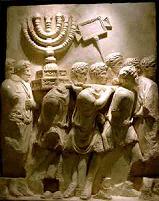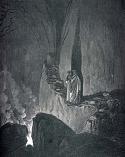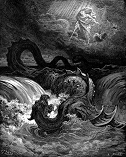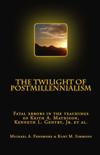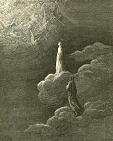A Critical Review of a Frost's Exposition ofRevelation Twenty
By
Kurt Simmons
[Editor's Note: This article was written in response to an article by Samuel Frost; to read this article, click here.]
Introductory Remarks
In a recent exposition of Revelation twenty, a writer attempted to show that 1) the first resurrection refers to the regeneration of Israel during the period beginning in 33 A.D. and ending on or about 66 A.D; 2) the battle of Gog and Magog is the Jewish war with Rome (A.D. 66-70). Although the writer did a capable job showing a correlation between certain portions of Ezekiel and Revelation, in the end his analysis errs and he fails to sustain the propositions he set out to prove.
I. Ezekiel’s Prophecies
Our writer’s analysis of the first resurrection largely ignores the language of Revelation twenty, building instead upon the prophet Ezekiel. Hence, let us begin by reviewing Ezekiel’s prophecies. The prophet Ezekiel was a captive during the Babylonian siege and deportation of Judah. The prophecies of Ezekiel may be divided into three parts: Chapters 1-24 contain threatened judgments and the fall of Jerusalem; chapters 25-32 contain prophecies against foreign nations; chapters 33-48 speak to the future comfort and consolations of Israel. Frost builds his case from the contents of chapters 37-48.
After the fall of Jerusalem, Ezekiel was taken in vision to a valley full of dry bones. (Ezek. 37:11) Ezekiel was told to prophesy to the bones, saying, “Thus saith the Lord God unto these bones; Behold, I will cause breath to enter into you, and ye shall live.” (vv. 4, 5) Upon prophesying, the bones came together, were clothed with flesh, and stood upon their feet, “an exceeding great army.” (vv.7-10) The interpretation of the vision is provided in vv. 11-14. The bones represented the “whole house of Israel,” viz., the northern and southern tribes. In their captivity, the tribes bemoaned their national death, saying, “our bones are dried, and our hope is lost.” (v. 11) However, God would revive his people by putting his Spirit in their midst through the words of the prophets, take them out of the “grave” of their national captivity, and restore them to their land: “Thus saith the Lord God; behold, O my people, I will open your graves, and cause you to come up out of your graves, and bring you into the land of Israel.” (v. 12)
Ezekiel’s prophecies do not stop with Israel’s national restoration to its land, but look beyond the return of the captivity unto the kingdom of Christ. Thus, there would come a time to restored Israel when “David my servant shall be king over them…Moreover I will make a covenant of peace with them; it shall be an everlasting covenant with them: and I will place them, and multiply them, and will set my sanctuary in the midst of them for evermore….yea, I will be their God, and they shall be my people.” (vv. 24-28) In the last days (Ezek. 38:8, 16), after coronation of “David the King,” but before completion of the new Jerusalem and temple (Ezek. 40-48), restored Israel would suffer depravations by an invasion of pagan hoards nominated as “Gog and Magog.” (Ezek. 38, 39) However, God would fight against Gog and Magog: “And I will plead against him with pestilence and with blood; and I will rain upon him, and upon his bands, and upon the many people that are with him, an overflowing rain, and great hailstones, fire, and brimstone.” (Ezek. 38:22) The slain of Gog and Magog would be meat for the fowls of heaven and beasts of the earth: “And, thou son of man, thus saith the Lord God; Speak unto every feathered fowl, and to every beast of the field, Assemble yourselves, and come; gather yourselves on every side to my sacrifice that I do sacrifice for you, even a great sacrifice upon the mountains of Israel, that ye may eat flesh, and drink blood.” Defeat of Gog and Magog would manifest God’s judgments among the heathen. “The heathen shall see my judgment that I have executed, and my hand that I have laid upon them. So the house of Israel shall know that I am the Lord their God from that day and forward.” (Ezek. 39:17-22; cf. Rev. 19:11-21)
II. Our Writer’s Analogization
For our writer, the Babylonian captivity is a type of Israel’s and mankind’s banishment from the presence of God because of Adam’s sin. The pouring out of the Spirit on Pentecost answers to Israel’s “return from exile.” The “resurrection of dry bones” in Ezekiel thirty-seven is a prophetical type of the “first resurrection” of Revelation twenty. Our writer argues that, because the phrase “and they lived” in 20.4, 5 (Grk. “kai ezesan”) occurs in the Greek Septuagint in Ezekiel 37.10, there is an identity of subject matter between the texts. For our writer, the breath that entered into the dry bones answers to the outpouring of the Holy Ghost on Pentecost, which he sees as the “the first stage of The Resurrection of the Dead,” or “first resurrection.” Israel dwelling safely in its land (Ezek. 38:8, 11) is national Israel under the Pax Romani; Gog and Magog are the Romans; the battle of Gog and Magog is the Jewish war with Rome:
“Spirit of God is ultimately poured out at Pentecost, the ‘return from exile’ for Israel, and indeed, for the world, had begun; the resurrection of the dead. Israel lives, under Rome, in relative peace and safety. In fact, Paul states this to be the case in I Thes. 5.3, quoting a familiar OT phrase. Rome (Gog and Magog) invades and Israel ‘according to the old covenant’ is dissolved, whereas Israel according to the Spirit and new covenant is redeemed into her heavenly Land, cleansed, ‘never again to be defiled.’”
Analysis
III. Regeneration is not The First Resurrection
Our writer characterizes the issue in identifying the “first resurrection” as a question of “When did God begin to raise the dead?”[1] It is more than a little significant that the question in couched in terms of the “first stage” and “beginning” of the resurrection of the dead. These terms occur nowhere in Revelation twenty; John does not say they “began to live and reign,” or that this was the “first stage” of their living and reigning with Christ. In fact, these terms never occur in connection with the resurrection at all! Not one New Testament writer ever uses them. We should always endeavor to speak as the oracles of God. (I Pet. 4:11; I Cor. 2:13) When we encounter unbiblical terminology, it is often a good hint that we may be departing from the word of God. The question becomes, why should our writer find it necessary to modify reference to the resurrection by language nowhere occurring in scripture? Why does he find it necessary to say that Pentecost marked the “beginning” or “first stage” of the resurrection?
The answer to this lies in the writer’s belief that the “first resurrection” spoke to the “pre-end-of-the-age-saints” who purportedly came to life (were regenerated) prior to the consummation in A.D. 70.[2] However, because the resurrection did not actually occur until the consummation of the Mosaic age (“The ‘first resurrection’ was consummated at the end of the age, not at the Pentecostal beginning of Christ’s age-changing reign”[3]), our writer finds it necessary to say it “began” at Pentecost. In other words, our writer must “stretch” the resurrection from the A.D. 70 consummation backwards to A.D. 33 so as to include the “first fruit” Jews who presage the rest of the “harvest.”[4] The resurrection must “begin” with the firstfruit Jews, as he calls them, because, strange to relate, there is an “organic bond” between them and the “rest of the dead” (Old Testament Israel, as per our writer) whereby the baptism of the firstfruit Jews effects a vicarious redemption of their dead ancestors. (“The ONLY WAY Israel could be redeemed is through the body of Christ… Therefore, they were made MEMBERS of that body through Spirit’s applying of blessings upon the firstfruits so that through the part, the whole could also be included.” “Were it not for the response of the baptized remnant or firstfruit Jews, Israel would have been left to perish.”[5]) Thus it is that our writer’s use of unbiblical terminology about the “beginning” or “first stage” of the resurrection is very deliberate and intended to accommodate unbiblical beliefs about the vicarious redemption of Old Testament Israel through New Testament Jews.
Of course, the notion that the first resurrection is regeneration cannot be squared with the fact that the regeneration (new heavens and earth) did not come until the consummation in A.D. 70. It is not until after the general resurrection (Rev. 20:11-15) that the new heavens and earth come, there is no more death, and God proclaims “Behold, I make all things new.” (Rev. 21:1,4, 5) Since the first resurrection preceded the general resurrection and ended before the new heavens and earth began, it is axiomatic that the first resurrection cannot be regeneration. Prior to the consummation, the whole creation groaned and travailed in pain, looking to the adoption, redemption, and manifestation of the sons of God. (Rom. 8:19-23) The “groaning” of the creation testified to the bondage of corruption (sin and death) that beset the sons of Adam. The earnest of the Spirit (gifts of the Holy Ghost) was given during the interim period between the cross and coming of Christ in token of God’s pledge to redeem the purchased possession. (Eph. 1:13, 14; cf. II Cor. 1:22; 5:5) Hence, far from being evidence of the ‘first stage” of the regeneration, the outpouring and attendant gifts of the Holy Ghost were proof that the regeneration had not yet come. Period. One cannot be a “little” regenerated any more than a “little” pregnant. Either you are or you aren’t. Until A.D. 70 no one was regenerated. Consequently, in saying that the first resurrection is regeneration our writer puts the cart before the horse. He senses this and therefore uses qualifying terms, saying, the resurrection “began” at Pentecost or that Pentecost was the “first stage” of the resurrection. This is a thinly veiled attempt bring the regeneration back to the last days of the Mosaic age in order to accommodate mistaken notions about the “firstfruits” and miscellaneous other errata, including false views of the first resurrection.
The timing of the regeneration is not the only thing refuting our writer’s approach. Even more fundamental is the fact that our writer has the participants of the first resurrection coming to life when they should be suffering death! John describes the first resurrection as consisting of those that were first martyred, then came to life in hades paradise (hence, a resurrection). Our writer has them coming first to life (regeneration) then suffering death. Where is the resurrection in this? Hence, our writer’s approach completely reverses what John says.
Rev. 20:4 describes the first resurrection as consisting chiefly of the souls of those that were beheaded under the beast. They were martyred for not receiving its mark or worshipping its image. Having suffered martyrdom, these saints came to life and lived and reigned with Christ “a thousand years.” The mark of the beast is universally recognized in Preterist circles with the persecution under Nero, whose name in Hebrew letters produce the numeric value of the beast. (Rev. 13:18) The beast is further identified by the seven heads, which answer to seven kings, five of whom were fallen, albeit the sixth king was still reigning. (Rev. 17:10) The first five emperors of Rome were Julius, Augustus, Tiberius, Caius Caligula, and Claudius. Nero was the sixth emperor and was reigning at the time Revelation was written. “Worshipping the beast’s image” in Revelation twenty is a reference to the “false prophet.” The beast rises from the sea, the false prophet from the land. (Rev. 13:1, 11) The sea refers to the heathen inhabitants of the Mediterranean; the land is a reference to Judea. Hence, the false prophet is a symbol of persecuting power of Jewry, a reference to Jewish authorities who undertake an inquisition against Christians by the authority of Nero.
Mention of the mark of the beast and the worshipping of its image are time indicators and show that the context of Revelation twenty is decades removed from Pentecost and the outpouring of the Holy Ghost. Nothing John describes about the first resurrection directs our attention to Pentecost. It would never occur to any one reading references to the martyrs, the beast, its mark, and its image that Pentecost is in any way remotely alluded to. There are no allusions to tongues of fire upon the heads of the apostles, no allusions to the baptism of the three thousand, nothing. To the contrary, the whole scene of the martyrs in Revelation twenty is set in the persecution under Nero in A.D. 64-68. Indeed, from the letters to the churches to the symbolism of the book itself, the whole of Revelation pivots upon the crisis that would overtake the church in the persecution under Nero – the “hour of temptation,” which would come upon all the world. (Rev. 3:10; cf. 7:14) Chapter seventeen describes the beast being driven by the whore (Jerusalem/Jewry) in a surfeit of blood and slaughter of the saints. Eighteen depicts the defeat of the harlot, nineteen the fall of the kings of the earth, the false prophet, and the beast. Chapter twenty describes the defeat of the dragon. Hence, we are decades beyond Pentecost. This is not the birth of the church; it is the church in the crisis of persecution.
Jesus said, “Be thou faithful unto death, and I will give thee a crown of life…He that overcometh shall not be hurt of the second death.” (Rev. 2:10, 11) “To him that overcometh will I grant to sit with me in my throne, even as I also overcame and am sit down with my Father in his throne.” (Rev. 3:21; emphasis added.) The martyrs have overcome; they have been faithful unto death and have given their lives in testimony under the beast. Hence, they live and reign in Paradise a “thousand years” with Christ pending their eternal inheritance in heaven. John says the first resurrection consists of those that died under the beast who subsequently came to life in Paradise. Based upon his analogy from Ezekiel’s vision of dry bones, our writer says the first resurrection is the outpouring of the Holy Ghost at Pentecost; that the saints came to life first and were martyred later – precisely the opposite of what John says. He also places the regeneration before the consummation of the Mosaic age. Clearly, our writer’s interpretation must be rejected. It simply cannot be sustained by the text.[6]
IV. The Valley of Dry Bones Does not Refer to Pentecost
Our writer has it that Ezekiel’s vision of dry bones is an allusion to Pentecost and the outpouring of the Holy Ghost, or at least to the regeneration which allegedly began at that time. We disagree. Although one may analogize the vision to the outpouring of the Holy Ghost (one can always analogize), certainly no New Testament writer does. There is no passage in the Old or New Testaments one can point to where Ezekiel’s vision of dry bones is applied to Pentecost. Instead, as our writer concedes, Ezekiel and subsequent prophets almost certainly understood the vision of dry bones in reference to the national restoration of Israel from Assyria and Babylon. Similar language concerning the Spirit occurs in other texts about the return of the captivity. In fact, in chapter thirty-six, the chapter immediately preceding Ezekiel’s vision of dry bones, God states:
“I will take you from among the heathen, and gather you out of all countries, and will bring you into your own land. Then will I sprinkle clean water upon you, and ye shall be clean: from all your filthiness, and from all your idols, will I cleanse you. A new heart also will I give you, and a new spirit will I put within you: and I will take away the stoney heart out of your flesh, and I will give you an heart of flesh. And I will put my spirit within you, and cause you to walk in my statutes, and ye shall keep my judgments, and do them. And ye shall dwell in the land that I gave your fathers; and ye shall be my people, and I will be your God.” (Ezek. 36:24-28; cf. 11:16-21)
This prophesy mirrors the vision of dry bones in every material fact. Putting his Spirit in his people spoke to their willingness to receive the word of God at the mouth of their prophets; it spoke to the people’s willing heart to serve and obey God. It was fulfilled in the return of the captivity under Ezra and Nehemiah. Clearly, God’s putting his Spirit in his people in no way points to Pentecost or the “beginning” of the resurrection in this passage. If this passage does not apply to Pentecost, why should the vision of dry bones? Mention of “David the King” in following passages (Ezek. 37:15-28) held out the promise of the coming Messiah following the return out of Babylon. Zechariah is to the same effect, the restoration of Israel to the land precedes the coming the “Branch of David.” (Zech. 1:16; 2:6; 3:8) The prophet Daniel follows the same pattern. The street and wall would be rebuilt “even in troublous times,” followed several hundred years later by the Messiah. (Dan. 9:25, 26) This order (return of the captivity followed by “David the King”) is reversed if the vision of dry bones is made Pentecost. It reverses this order because Christ’s advent and appearance preceded Pentecost, whereas in Ezekiel’s vision the coming of Christ follows the resuscitation of dry bones. Hence, as before, our writer’s approach reverses the established Biblical arrangement. Ezekiel’s vision of dry bones no more refers to Israel’s soteriological resurrection than Daniel’s rebuilding the street and walls. Of course, even if it could be shown that the vision of dry bones looked beyond the return of the captivity to the regeneration, this would not prove that regeneration is the first resurrection. As already shown, the regeneration came after the first resurrection (the rest of the soul in paradise) had ceased to exist.
The vision of Ezekiel is built upon one return from captivity, our writer has two. First, he has Israel return out of captivity, dwelling safely in the land under the Pax Romani, then he has Israel return out of the exile of sin in the outpouring of the Holy Ghost. One Israel, two returns, or is it two Israels, two returns? I confess I cannot tell. If Pentecost is the reassembling of the dry bones, where were they scattered? Our writer suggests they were under the exile of sin in banishment from God, but Ezekiel’s vision has the bones cut off from one another, not from God. (Ezek. 37:11) In fact, God was very clear that he would be with the captivity while they were in Babylon. (See Jeremiah 24 and the vision of the two baskets of figs.) In either event, the analogy is hopelessly confused and breaks down to the point of refuting our writer’s argument entirely.
The fact that the phrase “and they lived” occurs in both Ezekiel and Revelation is purely circumstantial and is the weakest sort of evidence. Its probative value is so slight as to hardly merit mentioning. Numbers records that those who were bitten of serpents and looked upon the brazen serpent made by Moses “lived,” were they members of the first resurrection? In Deut. 5;26, Moses asks, “Who is there of all flesh, that hath heard the voice of the living God speaking out of the midst of the fire, as we have, and lived?” Does occurrence of the phrase “and lived” here mean the Israelites were members of the first resurrection?
Our writer has it that Rome is Gog and Magog that invades restored Israel in the war of A.D. 66-70. (“The imagery of the Gog and Magog battle is, among Preterists, the events of the last days of Jerusalem in the Jewish War.”) But, according to Ezekiel’s vision, it is spiritual Israel under “David the King” which is attacked by Gog and Magog, not apostate, national Israel. The most cursory reading of Ezekiel 38, 39 shows that the Lord God wages battle in behalf of restored Israel, destroying the invading force of Gog and Magog. In our writer’s analogy, it is just the opposite, Gog and Magog destroy national Israel. (“Rome (Gog and Magog) invades and Israel ‘according to the old covenant’ is dissolved.”) Our writer attempts to deal with this by saying the Jew’s revolt from Rome was religiously motivated so they could persecute Christians under cover of war-time anarchy. But, not only is there is no evidence anywhere this ever actually occurred, it is completely implausible. Just the opposite, in the war with Rome, Jewish citizens in foreign cities were all slain and the Christians of Jerusalem all fled.[7] Hence, there would have been little or no occasion for Jews to direct their energies against Christians under these circumstances. Certainly, after the revolt there would have been no official assistance from Rome in persecuting the church as portrayed in Revelation. (Rev. 13:12) In short, the hypothesis has no basis in fact. Surely, the better view is that Gog and Magog symbolize the persecution under Nero and the Jews. “Surrounding the beloved city and camp of the saints” is an attack upon the church, not the Roman siege of apostate national Israel. The fire that comes down from heaven devouring Gog and Magog is God’s judgment upon the Jews and Romans, marked by the destruction of Jerusalem and the civil wars that enveloped the empire following Nero’s suicide.
Conclusion
The book of Revelation does indeed draw from the imagery of Ezekiel. Images of the return of the captivity often looked beyond the immediate historical circumstances confronting the people to the coming of the Messiah. However, prophetic passages must not be wrested from their context; the simple ability to make an analogy does not prove a particular passage was intended to be so construed. In the case of the valley of dry bones, the acknowledged application is to the return of the captivity from Babylon. To make this prophecy apply to Pentecost and the first resurrection cannot be done without considerable violence to the text.
Notes:
[1] “The important point here is when did God begin to do this? ‘When’ in both the Greek and Hebrew texts is used in 37.13: ‘When I open your graves…and I will put my Spirit in you so that you may live’ – zesesthe, Greek).
[2] Max R. King, The Cross and the Parousia of Christ (Warren OH, 1987), p. 248.
[3] Ibid, p. 249. King has it that the resurrection occurs in three distinct stages: Christ, then those that are his at his coming (the first fruits), followed by the rest of the dead. Ibid, p. 632
[4] Actually, our writer believes that the resurrection occurred beginning AD 66 and was concurrent with the destruction of Jerusalem. However, it is clear from scripture that the resurrection follows the destruction of the harlot and is not concurrent with it. (Rev. 19:8, 9; Matt. 22:7, 8)
[5] Sam Frost, A Second Critical Response to Kurt Simmons’ Bimillennialism; Max R. King, The Cross and the Parousia of Christ, p. 515, 516. “This is clearly a case of vicarious or representative redemption… From this there is no escape.”
[6] Another area where our writer errs is in equating regeneration with resurrection. Regeneration speaks to the right condition of man before his maker on this side of eternity (Tit. 3:5); resurrection speaks to the life of the spirit on the other side of eternity. Our writer almost invariably fails to make this distinction, treating man’s regeneration on this side of eternity as the eschatological resurrection.
[7] Eusebius, Ecclesiastical History, III, v, 3; Loeb ed. Josephus, Wars of the Jews, II, xviii, 8; Whiston ed; Josephus, Wars of the Jews, II, xviii, 2; Whiston ed
To receive Kurt Simmons’ e-mail newsletter, The Sword & The Plow, click the Subscribe link:
All rights reserved.
